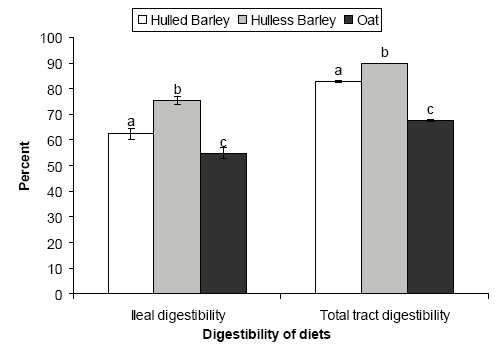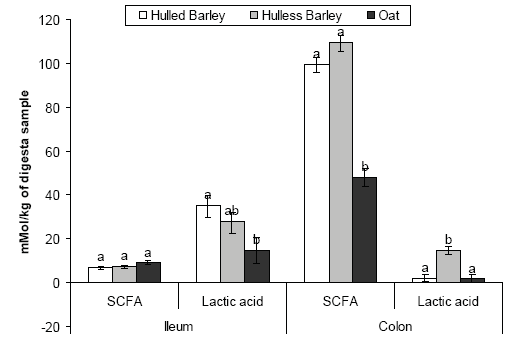Hulless Barley as Health-Promoters for the Pig’s Gastrointestinal Tract
Published: November 17, 2008
By: Prairie Swine Inc. Annual Research Report
INTRODUCTION
The consumer is increasingly concerned about the impact of nutrition on his health. Namely, he wants pork products devoid of antibiotic residues because he fears that the latter could be responsible for the development of bacteria resistant to antibiotics. For their part, pork producers are aware that the pig gastrointestinal tract must remain healthy in order to maximize the use of the nutrients and to prevent the occurrence of diarrhoea. Different alternatives are currently tested in many laboratories. Among them, “prebiotics” are of particular interest. These plant extracts are used as substrates by health-promoting bacteria (Lactobacilli, Bifidobacteria) and the latter grow at the expense of pathogenic ones (Salmonella, E. coli) in the pig tract. However, their extraction is expensive and their efficacy not obvious, namely because their inclusion rate in the diet is limited. Moreover, diet composition is rarely considered when the efficacy of these compounds is evaluated.
Some cereal non-starch polysaccharides (NSP), such as the β-glucans of barley, have demonstrated prebiotic properties. Whole hulless barleys would thus provide large amounts of fermentable NSP, namely β-glucans and it can thus be hypothesized that the intake of hulless barleys with high β-glucan levels will promote gut health. A series of experiments was carried out at Prairie Swine Centre to evaluate that hypothesis. The effect of diff erent hulless barley varieties was compared to that of hulless barleys or oats.
MATERIALS AND METHODS
A total of 72 weaned pigs (initial weight 13 ± 2 kg) were fed individually a diet composed of 81.5% cereal, 6% whey, 9% soy protein isolate and 3.5% minerals, including an indigestible marker. The cereals were hulled barley (reference), 4 hulless barleys (SB 90300, SB 94893, CDC Fibar and CDC McGwire) with β-glucan contents ranging from 30 to 84 g/kg DM and 2 oat varieties (CDC Sol-Fi and CDC Baler) with β-glucan content 32 and 23 g/kg DM respectively. After an adaptation period of 12 d, faecal samples were collected for 3 d and on day-16, pigs were killed 4h after the last meal and the ileal and colonic contents were collected. Digesta samples were analysed for short-chain fatty acids (SCFA), lactic acid (LA) and ammonia. The DNA of the bacteria present in the samples was also isolated and analysed by molecular techniques in order to determine the composition of the bacterial population.
RESULTS AND DISCUSSION
The ileal DM digestibility (Figure 1) was higher (P<0.05) for diets based on hulless barleys (75% on average), as compared to hulled barleys (62%) and oats (55%). Similar trends were found for total tract digestibility (Figure 1), varying from 90% in hulless barley to 68% in oats. The digestibility value of the hulless barley is comparable to that of wheat or corn.
Figure 1. Ileal and total tract digestibility of different diets

There were mixed results in terms of fermentation end-products (Figure 2).
Short-chain fatty acid (SCFA) concentrations did not differ between the hulled and hulless barleys and oats (P > 0.05) at the ileum level whereas in the colon, the SCFA concentration was markedly (>50%) lower (P < 0.05) in pigs fed oats. The production of lactic acid in the colon was significantly (P <0.0001) higher in pigs fed hulless barleys, as compared to hulled barleys and oats. This confirms the fact that the dietary fibre fraction of hulless barleys is more fermentable than the hulls of common barleys and oats. This high fermentability will also enhance the development of bacteria such as Lactobacilli and Bifidobacteria, which are beneficial to gut health (see below).
Figure 2. Fermentation end products at the ileum and colon of pigs fed different types of barley and oats

Ammonia production is the outcome of proteolysis in the intestinal tract and its concentration in the intestinal contents increases when there is not enough carbohydrate substrate available for fermentation by the microbiota. Ammonia is a harmful metabolite, especially for young piglets. Its concentration should thus be minimized, by providing the animal with less indigestible dietary proteins and more fermentable carbohydrates. In this study, ammonia production was significantly higher (P <0.05) in both hulled and hulless barleys, as compared to oats (Table 1).
Table 1. SCFA and Ammonia produced in the colon of pigs fed different diets.

Table 2. Mean ± SD copy numbers (log copies/μl DNA) of 16S rRNA gene of microbial groups in Ileum and Colon genomic DNA. Numbers in parentheses indicate the number of colonized piglets

n.d. Not detected
However, the proportion of the SCFA and ammonia did not differ significantly (P < 0.05) in either group of pigs. Thus, in our current conditions, hulless barleys did not provide any advantage in terms of ammonia concentration in the gut.
The analysis of the microbial population in the intestines of pigs revealed that potentially pathogenic bacteria such as Streptococci and Enterobacteria disappear from the ileum of pigs fed with hulless barleys (Table 2). Although this observation will need confirmation, it is encouraging as it confirms the “prebiotic” potential of β-glucan in swine nutrition. On the contrary, no significant effect of cereal intake was observed on the bacterial population at the colonic level.
CONCLUSION
The presence of large amounts of soluble β-glucans in some hulless barley varieties does not seem to be a concern for their overall nutritional value in swine since they were better digested than common hulled barleys and oats. The presence of higher amounts of fermentable fi bre led to the production of larger amounts.
Both oats and hulless barleys have high β-glucan content that could be of interest to improve pig gut health. Hulless barleys are better digested by the pig and have higher fermentation rates in the colon than oats and reduce the presence of harmful bacteria at the ileum level. Thus, hulless barley is of great interest for both swine nutrition and gut health.
ACKNOWLEDGEMENTS
National Pork Board (project # 06-117) Alberta Barley Commission (project # 60-192) acknowledged for funding this study. The continuing core support of the Prairie Swine Centre received from Sask Pork, Manitoba Pork Council, Alberta Pork and the Saskatchewan Agriculture Development Fund is gratefully acknowledged. Authors also thank to Bryan Grimmelt for his support during laboratory analysis.
By R. Jha1,2, B. Rossnagel2, P. Kish1, R. Pieper3, A. Van Kessel2, P. Leterme1
1 Prairie Swine Centre Inc. P. O. Box 21057, 2105 8th Street East, Saskatoon, Saskatchewan S7H 5N9,
2 University of Saskatchewan, Saskatoon, Canada; 3 FBN-Ernahrüngsphysiologie, Dummerstorf, Germany
Published by Prairie Swine Inc. (2007 Annual Research Report)
Source
Prairie Swine Inc. Annual Research ReportRelated topics:
Recommend
Comment
Share

Would you like to discuss another topic? Create a new post to engage with experts in the community.







